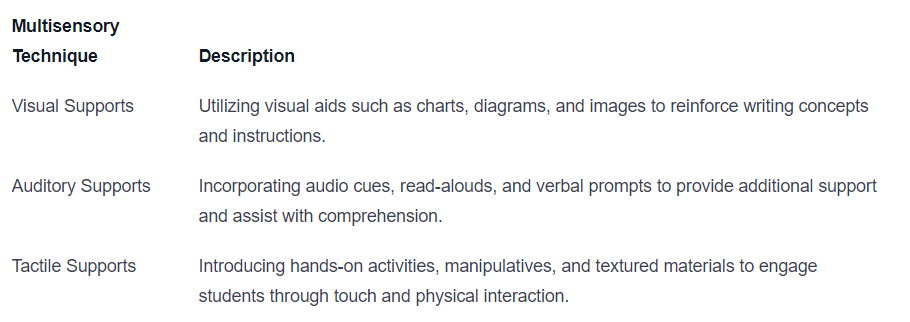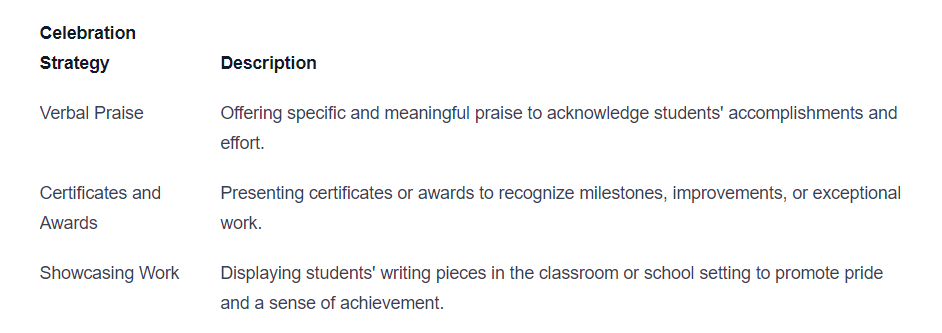Teaching Writing to Students with Autism
Unlock the power of writing for students with autism. Learn effective strategies to support their unique needs in the writing process.

Teaching Writing to Students with Autism
Teaching writing to students with Autism Spectrum Disorder (ASD) requires a comprehensive understanding of their unique needs and challenges. By employing appropriate strategies and supports, educators can effectively support students with autism in the writing process.

Understanding Autism Spectrum Disorder (ASD)
Autism Spectrum Disorder (ASD) is a neurodevelopmental disorder that affects social interaction, communication, and behavior. It is characterized by a wide range of symptoms and varying degrees of severity. Students with ASD may exhibit difficulties in areas such as social communication, sensory processing, executive functioning, and self-regulation.
To effectively teach writing to students with ASD, it is important to recognize the individual differences within the spectrum and tailor instructional approaches accordingly. Understanding the core features of ASD, such as challenges in social interaction and communication, is crucial in creating a supportive learning environment for these students.
Challenges Faced by Students with Autism in the Writing Process
Students with autism face specific challenges throughout the writing process. These challenges can include:
- Organization and Planning: Difficulties in organizing thoughts and ideas, making it challenging to structure and outline written work.
- Expressive Language: Limited verbal expression and challenges in effectively conveying ideas in written form.
- Sensory Sensitivities: Sensory sensitivities to sounds, textures, and visual stimuli may distract or overwhelm students during the writing process.
- Executive Functioning: Difficulties in managing time, initiating tasks, and sustaining attention can impact the ability to complete writing assignments.
- Fine Motor Skills: Fine motor challenges may affect handwriting legibility and speed, making it harder to produce written work.
By understanding these challenges, educators can implement targeted strategies and supports to help students with autism overcome these barriers and develop their writing skills. Through a supportive and inclusive approach, teachers can foster a positive learning environment where students with autism can thrive in their writing endeavors.
Strategies for Supporting Students
When it comes to teaching writing to students with autism, implementing effective strategies can make a significant difference in their learning and development. Here are three strategies that can provide valuable support to students with autism in the writing process.
Creating a Structured Environment
Creating a structured and predictable environment is essential for students with autism. A structured environment helps to minimize distractions and provides a clear framework for the writing process. Consider implementing the following elements to create a structured environment:
- Establish a consistent writing routine with designated times and spaces for writing.
- Use visual schedules and timers to help students understand the sequence of writing activities.
- Clearly define expectations and rules for behavior during writing sessions.
- Provide a calm and organized workspace with minimal visual and auditory distractions.
By creating a structured environment, students with autism can better focus on the writing task at hand, reducing anxiety and improving their overall writing experience.
Visual Supports and Prompts
Visual supports and prompts can greatly enhance the writing experience for students with autism. Visual aids provide a concrete and visual representation of the writing process, helping students understand and follow the steps involved. Consider using the following visual supports and prompts:
- Writing checklists: Provide a visual checklist that outlines the steps involved in the writing process, such as brainstorming, drafting, revising, editing, and proofreading.
- Writing templates: Use graphic organizers or writing templates to provide a visual framework for organizing ideas and structuring the writing piece.
- Visual cues: Utilize visual cues and symbols to prompt students during the writing process, such as visual reminders for capitalization, punctuation, and paragraph breaks.
By incorporating visual supports and prompts, students with autism can better comprehend and navigate the complexities of the writing process, leading to improved writing outcomes.
Individualized Instruction and Differentiation
Recognizing the unique strengths and challenges of each student with autism is crucial in providing effective writing instruction. Individualized instruction and differentiation allow educators to tailor their teaching approaches to meet the specific needs of each student. Consider the following strategies for individualized instruction and differentiation:
- Assess each student's writing abilities and create personalized goals and objectives.
- Modify writing tasks based on each student's skill level and areas of need, providing appropriate challenges and support.
- Use a multi-sensory approach to engage students with different learning styles, incorporating visuals, auditory cues, and hands-on activities.
- Provide direct and explicit instruction, breaking down writing tasks into manageable steps and providing clear explanations.
By offering individualized instruction and differentiation, educators can support students with autism in a way that maximizes their strengths and facilitates their progress in the writing process.
Implementing these strategies can help create a supportive and inclusive learning environment for students with autism, enabling them to develop their writing skills and reach their full potential.
Pre-Writing Stage
The pre-writing stage is a crucial step in the writing process for students with autism. This stage involves brainstorming and organizing ideas before putting them onto paper. By providing the right supports and strategies, educators can help students with autism effectively navigate this stage and lay a strong foundation for their writing.
Brainstorming and Organizing Ideas
Encouraging students with autism to generate and organize their ideas is an essential step in the pre-writing stage. Here are some strategies to support this process:
- Promote verbal and written brainstorming techniques, allowing students to express their thoughts through spoken or written words.
- Use prompts or open-ended questions to stimulate ideas and encourage students to think creatively.
- Teach students how to use concept maps or idea webs to visually organize their thoughts. These graphic organizers can help students make connections between different ideas and concepts.
Graphic Organizers and Mind Maps
Graphic organizers and mind maps are excellent tools for students with autism to visually structure their ideas. These visual supports help students see the relationships between concepts and provide a clear framework for their writing. Here are some common types of graphic organizers and mind maps:

These tools can be customized to fit the specific needs of each student and the writing task at hand. The use of colors, symbols, and images can enhance engagement and comprehension for students with autism.
Utilizing Visual Supports
Visual supports play a crucial role in supporting students with autism during the pre-writing stage. These supports provide additional structure and clarity to the writing process. Here are some examples of visual supports:
- Writing checklists: Visual checklists can help students remember the necessary steps to complete during the pre-writing stage, such as brainstorming, organizing ideas, and selecting a topic.
- Templates: Pre-designed templates can guide students through the process of organizing their ideas. These templates can include sections for main ideas, supporting details, and transitions.
- Pictorial cues: Incorporating visual cues, such as icons or symbols, can help students understand and remember the different stages of the pre-writing process.
By utilizing these strategies and tools, educators can help students with autism effectively navigate the pre-writing stage. This sets the stage for a successful writing experience and supports the development of their writing skills.
Drafting and Revising Stage
During the drafting and revising stage of the writing process, it is crucial to provide targeted support to students with autism. By breaking down the writing process, providing explicit instruction and modeling, and using scaffolding techniques, educators can effectively guide students through this stage.
Breaking Down the Writing Process
For students with autism, the writing process can be overwhelming if presented as a whole. Breaking it down into smaller, manageable steps can make it more accessible. By clearly defining each step and providing visual cues, students can better understand and navigate the writing process.
Writing Process Steps
Pre-writing
Drafting
Revising
Editing
Publishing
Providing Explicit Instruction and Modeling
Explicit instruction and modeling are vital components of teaching writing to students with autism. Clear and specific instructions, along with visual supports, can help students grasp the concepts and expectations of each writing task. By demonstrating the desired writing skills and strategies, educators can provide a model for students to follow.
Explicit Instruction and Modeling
Clearly explain the purpose and goals of the writing task.
Demonstrate how to generate ideas and organize them.
Model the process of writing a draft, including sentence structure and paragraph development.
Show examples of revision techniques, such as adding details or improving sentence fluency.
Using Scaffolding Techniques
Scaffolding techniques can provide additional support to students with autism during the drafting and revising stage. These techniques help students build their writing skills gradually, while still allowing them to contribute their thoughts and ideas. Some effective scaffolding techniques include:
- Sentence Starters: Provide sentence starters or prompts to help students begin their sentences. This can reduce the cognitive load and give students a starting point for their writing.
- Guided Questions: Ask guided questions to prompt students to think critically about their writing. These questions can help students focus on specific aspects of their writing, such as organization, clarity, or supporting evidence.
- Peer Collaboration: Encourage peer collaboration and feedback. Pairing students with autism with their peers can foster social interaction and provide an opportunity for constructive feedback and support.
By implementing these strategies during the drafting and revising stage, educators can effectively support students with autism in developing their writing skills. Breaking down the writing process, providing explicit instruction and modeling, and utilizing scaffolding techniques can help students build confidence and achieve success in their writing endeavors.
Editing and Proofreading Stage
During the editing and proofreading stage of the writing process, specific strategies can be employed to support students with autism in developing their editing skills, providing clear and specific feedback, and encouraging self-reflection.
Developing Editing Skills
To help students with autism develop their editing skills, it is important to break down the process into manageable steps. This can be achieved by providing explicit instruction on common grammatical and punctuation errors, such as capitalization, verb tense, and sentence structure. Utilizing visual aids, such as checklists or anchor charts, can help students remember and apply these editing rules consistently.
Additionally, engaging students in hands-on activities, such as interactive games or worksheets, can make the editing process more enjoyable and reinforce their understanding of editing concepts. By providing opportunities for practice and reinforcement, students can develop their editing skills over time.
Providing Clear and Specific Feedback
When providing feedback to students with autism during the editing and proofreading stage, it is essential to be clear, specific, and concise. Offering feedback that is focused on one or two specific areas for improvement allows students to better understand and implement changes effectively.
Using visual supports, such as color-coded highlighting or sticky notes, can help draw attention to specific areas in the student's writing that require revision. This visual cue can assist in making feedback more concrete and actionable.
Additionally, providing written or verbal examples of corrections can further support students in understanding the changes needed. Offering praise and encouragement for areas where the student has shown improvement can also help build their confidence and motivation in the editing process.
Encouraging Self-Reflection
Encouraging self-reflection is a vital aspect of the editing and proofreading stage for students with autism. By fostering self-awareness and self-evaluation, students can take ownership of their writing and develop the ability to identify and correct errors independently.
One effective strategy is to guide students in using self-checklists or rubrics to evaluate their own work. These tools can help students identify areas that need improvement and set goals for future writing assignments. Reflective prompts, such as "What changes did you make to improve your writing?" or "What would you do differently next time?" can also encourage students to think critically about their writing process.
By promoting self-reflection, students with autism can develop a greater sense of autonomy and become more confident in their ability to edit and proofread their own writing.
The editing and proofreading stage is a crucial part of the writing process for students with autism. By focusing on developing editing skills, providing clear and specific feedback, and encouraging self-reflection, educators can support these students in becoming more proficient writers.
Enhancing Engagement and Motivation
Engaging and motivating students with autism in the writing process is essential for their success. By incorporating specific strategies, educators can create an environment that fosters active participation and enthusiasm. This section explores three effective approaches: incorporating multisensory techniques, tapping into special interests, and celebrating achievements and progress.
Incorporating Multisensory Approaches
Multisensory approaches involve stimulating multiple senses simultaneously to enhance learning and engagement. For students with autism, incorporating visual, auditory, and tactile elements can be particularly beneficial during the writing process. By appealing to different sensory modalities, educators can provide a more comprehensive and engaging experience.

By incorporating multisensory approaches, educators can create a dynamic and interactive learning environment that caters to the unique needs of students with autism.
Tapping into Special Interests
Tapping into the special interests of students with autism can be a powerful motivator during the writing process. Many individuals with autism have specific topics or subjects that capture their attention and spark their enthusiasm. By incorporating these special interests into writing assignments, educators can increase engagement and promote meaningful connections.

By aligning writing tasks with students' special interests, educators can tap into their intrinsic motivation and facilitate a more enjoyable and meaningful writing experience.
Celebrating Achievements and Progress
Celebrating achievements and progress is an essential component of supporting students with autism in the writing process. Recognizing and acknowledging their efforts can boost self-esteem, increase motivation, and foster a positive attitude towards writing. Educators can incorporate various strategies to celebrate achievements and progress.

By celebrating achievements and progress, educators can create a supportive and encouraging writing environment that empowers students with autism to become confident and skilled writers.
By implementing these strategies, educators can enhance engagement and motivation among students with autism, paving the way for successful and enjoyable writing experiences.
Sources
https://blog.stageslearning.com/blog/teaching-children-with-autism-writing-skills
https://www.time4learning.com/homeschooling/special-needs/autism/writing-strategies.html
https://www.speciallearninghouse.com/how-to-teach-an-autistic-child-to-write-15-tips/
Similar articles
We’re here to help you

Our team is here to assist you in this process. Contact us for any assistance.
it’s easy to apply
We Accept Most Insurances
Our in-network insurance partnerships make ABA therapy more accessible to families throughout our service areas.







Our Insurance Process
We'll request your insurance details to help us verify your plan's coverage for ABA therapy. Once we've received this information, we'll walk you through your benefits, including copayments, deductibles and out-of-pocket maximums, so you know what to expect in advance.
Our team will then handle the preauthorization and all the necessary paperwork.
.svg)





















.jpeg)


































.jpeg)




.jpeg)







.jpeg)











.jpeg)
















